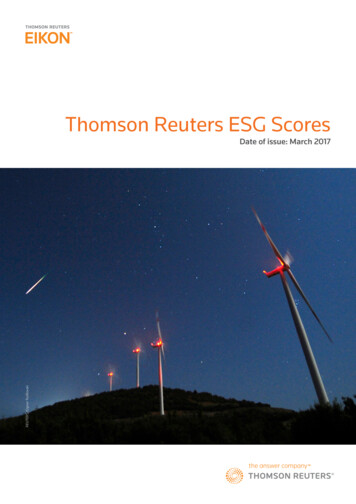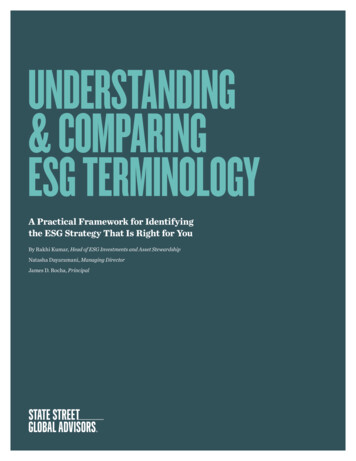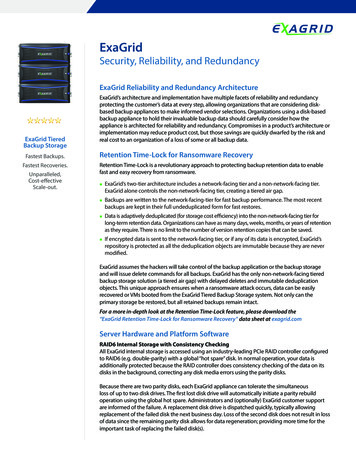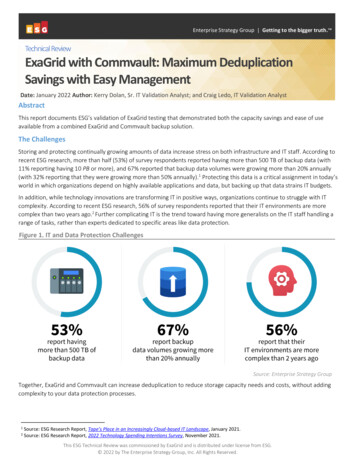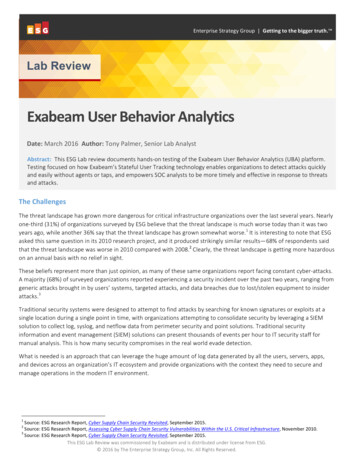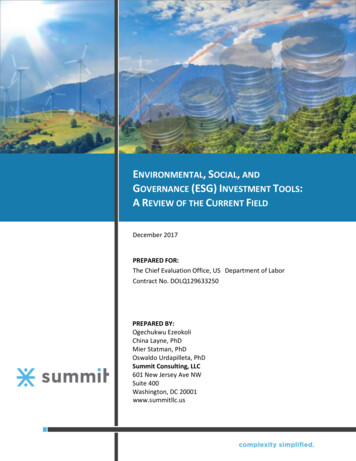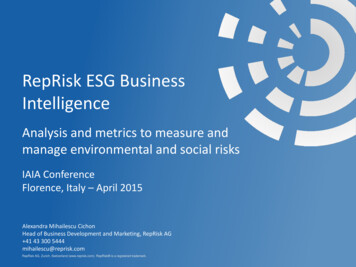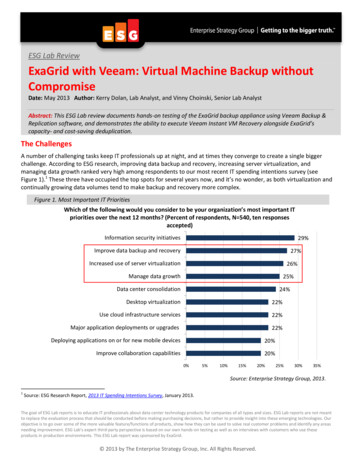
Transcription
ESG Lab ReviewExaGrid with Veeam: Virtual Machine Backup withoutCompromiseDate: May 2013 Author: Kerry Dolan, Lab Analyst, and Vinny Choinski, Senior Lab AnalystAbstract: This ESG Lab review documents hands-on testing of the ExaGrid backup appliance using Veeam Backup &Replication software, and demonstrates the ability to execute Veeam Instant VM Recovery alongside ExaGrid’scapacity- and cost-saving deduplication.The ChallengesA number of challenging tasks keep IT professionals up at night, and at times they converge to create a single biggerchallenge. According to ESG research, improving data backup and recovery, increasing server virtualization, andmanaging data growth ranked very high among respondents to our most recent IT spending intentions survey (seeFigure 1).1 These three have occupied the top spots for several years now, and it’s no wonder, as both virtualization andcontinually growing data volumes tend to make backup and recovery more complex.Figure 1. Most Important IT PrioritiesWhich of the following would you consider to be your organization’s most important ITpriorities over the next 12 months? (Percent of respondents, N 540, ten responsesaccepted)Information security initiatives29%Improve data backup and recovery27%Increased use of server virtualization26%Manage data growth25%Data center consolidation24%Desktop virtualization22%Use cloud infrastructure services22%Major application deployments or upgrades22%Deploying applications on or for new mobile devices20%Improve collaboration capabilities20%0%5%10%15%20%25%30%35%Source: Enterprise Strategy Group, 2013.1Source: ESG Research Report, 2013 IT Spending Intentions Survey, January 2013.The goal of ESG Lab reports is to educate IT professionals about data center technology products for companies of all types and sizes. ESG Lab reports are not meantto replace the evaluation process that should be conducted before making purchasing decisions, but rather to provide insight into these emerging technologies. Ourobjective is to go over some of the more valuable feature/functions of products, show how they can be used to solve real customer problems and identify any areasneeding improvement. ESG Lab’s expert third-party perspective is based on our own hands-on testing as well as on interviews with customers who use theseproducts in production environments. This ESG Lab report was sponsored by ExaGrid. 2013 by The Enterprise Strategy Group, Inc. All Rights Reserved.
ESG Lab Review: ExaGrid with Veeam: Virtual Machine Backup without Compromise2The flexibility of virtual machines (VMs) can cause serious managerial challenges. Deleting an entire VM unintentionally,including the applications installed on it, is easy to do. However, restoring VMs is not nearly as easy or fast when usingthe wrong approach. Backing up VMs provides assurance that in the case of an accidental deletion, failure, or disaster,you will be able to get the VMs back, so many organizations backup VMs with regularity. For recovery, users often haveto wait hours or even days.Instant Restore . . .A recent technology innovation was born out of the intersection of disk-based backup and server virtualization. A fewadvanced backup and restore solutions enable VMs that are saved on disk to be “instantly recovered” by simplypowering on VMs from the backup disk. This short-termed solution is designed to speed the user’s return to productivityso that time is not lost while IT finds and fixes the problem. . . Collides with DeduplicationHowever, a challenge for many vendors has arisen due to a conflict with another technology that has become crucial forefficiency and cost-savings as organizations work to manage ongoing data growth: deduplication. The capacity and TCOsavings available from this technology (particularly for backups that continually store redundant data) cannot beoverstated, and as a result it is rapidly becoming the norm for data protection. In the case of a disaster, IT can restoredata from a deduplicated backup, but the time required often exceeds today’s recovery time objectives (RTOs).So what about instant restore? Unfortunately, while instant restore works well with plain disk storage, it is not soeffective with deduplicated backup targets. The rehydration process required to recover target-based deduplicatedbackups involves reassembling the data from small blocks and extensive hash tables. In addition, starting up a VM addsthe strain of extremely random storage access, different from the sequential access typical of conventional full restores.These characteristics make the “instant” part of recovery virtually impossible, unless deduplication is optimized for diskbased backup.This leaves IT organizations with a dilemma when protecting VMs: They must choose between gaining back productivetime with instant restore, and minimizing storage capacity and cost with deduplication. Deduplication is crucial toreducing costs for virtual machines in particular, as VM backups often contain redundant copies of operating systemsand applications. For many, instead of choosing based on the priority of the benefit, they implement multiple storagesolutions for different data sets, driving up the costs of both equipment and management. For others, it means choosingone benefit and forgoing the other. 2013 by The Enterprise Strategy Group, Inc. All Rights Reserved.
ESG Lab Review: ExaGrid with Veeam: Virtual Machine Backup without Compromise3The Solution: ExaGrid Backup Appliance plus Veeam Backup & ReplicationTogether, ExaGrid and Veeam offer a solution that enables customers to enjoy the benefits of both deduplication andinstant recovery when protecting virtual machines in VMware vSphere and Microsoft Hyper-V environments. Inaddition, customers benefit from the combination of Veeam source-side deduplication and ExaGrid post-processdeduplication for maximum capacity reduction.ExaGridExaGrid offers a series of high-performance, scalable disk backup appliances with built-in, post-process deduplication.Each ExaGrid appliance is a turnkey backup solution that works seamlessly with industry-leading backup software, and isbuilt from components that include Intel quad-core Xeon processors, enterprise SATA drives in a RAID 6 configuration,and ExaGrid software. Appliances are simple to set up, speeding time to value, and protected data can be replicateddirectly to a remote ExaGrid appliance, offsite disk, or tape. A range of models includes up to 32TB of raw capacity perunit; these can be combined in grids of up to ten appliances for a total 320 TB of raw capacity capable of handling 130TBof primary data plus retention. This yields the equivalent of more than 2 PB of logical capacity that can be managed froma single console. As appliances are added to a grid, they each add CPU, bandwidth, memory, and disk capacity for linearscalability of capacity and performance.Patented zone-level deduplication occurs after backups have completed (post-process, not inline during the backupprocess) so that backups are executed as quickly as possible. By storing only unique bytes across backups, ExaGridprovides capacity savings of 10:1 to 50:1 over time.Landing ZoneA unique capability of ExaGrid appliances that enables instant restore is the “landing zone,” a high-speed cache wherebackups land before deduplication, and where a non-deduplicated copy of the most recent backup is held separatelyfrom the deduplicated backend (see Figure 2). Backups can be instantly recovered from the landing zone in just minutes,eliminating the wait time for a full restore from millions of deduplicated data chunks.Figure 2. ExaGrid Appliance with Veeam Backup & Replication 2013 by The Enterprise Strategy Group, Inc. All Rights Reserved.
ESG Lab Review: ExaGrid with Veeam: Virtual Machine Backup without Compromise4Veeam Backup & ReplicationVeeam Backup & Replication was built specifically for virtual environments, and offers application-aware backup andrecovery, granular restore, and replication for VMware vSphere and Microsoft Hyper-V virtual machines. It is easy to setup and uses no agents in VMs, eliminating the need to license, deploy, manage, and maintain them. Veeam can bedeployed with any disk storage, and its distributed architecture enables backup proxy VMs to reside at any locationwhile leveraging the Veeam backup server for scheduling and load balancing. It can scale to support any environment byadding proxies and/or backup servers. Veeam’s backup solution delivers powerful features including built-indeduplication and compression to reduce LAN bandwidth and storage capacity requirements.Veeam’s patented vPower technology enables the application to offer several unique capabilities: Instant VM Recovery – Veeam was a pioneer in instant recovery technologies. By exposing the virtualmachine files in a backup repository through a disk mount, Veeam enables a backed-up VM to be poweredon and used without having to wait for it to be fully restored. Local disk space serves as a temporary writearea, recording changes while the VM is running from the backup. The full VM migration is conducted in thebackground, after which the VM running from the backup disk can be migrated to production storage forcontinued operation.SureBackup – Automatic verification of the recoverability of backups. Many organizations don’t test therecoverability of backups because it requires additional dedicated resources and time. Instead, thoseresponsible for disaster recovery simply hope that if needed, their backups will be recoverable. SureBackupautomates verification using available resources in the production or test environment. Using Veeamtechnology, the VM is run in an isolated environment directly from the disk-based backup. Veeam starts theVM, boots the OS, confirms that the VM is functioning properly, and reports back to the VM administratorthat the VM(s) are indeed recoverable. Application-aware confirmation can be scripted to match corporatepolicies, and results can be used for DR audits.Other features include Universal Application-Item Recovery (U-AIR), which provides recovery of individual objects fromvirtualized applications; intelligent load balancing; a single view of centralized and remote office deployments fromVeeam Enterprise Manager; and simple, per-socket licensing. 2013 by The Enterprise Strategy Group, Inc. All Rights Reserved.
ESG Lab Review: ExaGrid with Veeam: Virtual Machine Backup without Compromise5Instant VM RecoveryInstant recovery capabilities are closely tied to the type of storage used for backup. To provide some context, Figure 3shows three different disk backup options and how they operate. At the bottom of the figure is plain disk storage, with no deduplication. The backups are sent directly to disk,stored as written by the backup application, and recovered directly from disk. Data can be instantlyrecovered from the disk repository.In the middle is an example of a disk backup target that includes a cache and in-line deduplication. Backupsare deduplicated as the backup is being written to disk, trading some backup window time for the benefit ofreduced disk capacity. The backup is not stored as written by the backup application, but instead is stored asdeduplicated chunks. Standard restore is accomplished by rehydrating the data chunks from the disk inconjunction with a hash table. Instant recovery is not effective here as there is no non-deduplicated data.Instant recovery techniques can be executed, but may take hours (exceeding today’s RTOs), and often fail.At the top of the figure is an ExaGrid disk target. The ExaGrid landing zone provides a high-speed cachewhere the last full (or synthetic full) backup and any incremental backups are stored as written by thebackup application, while deduplication processing occurs on the appliance after the backup has finished.This enables the capacity savings of deduplication, while leaving a copy of the most recent backup intact andavailable for instant recovery. In an instant recovery scenario, VMs are powered on and run while accessingthe selected recovery point stored in the ExaGrid landing zone.Figure 3. Disk-based Backup and Recovery Comparison 2013 by The Enterprise Strategy Group, Inc. All Rights Reserved.
ESG Lab Review: ExaGrid with Veeam: Virtual Machine Backup without Compromise6ESG Lab TestingESG Lab tested the Instant VM Recovery capability of the ExaGrid and Veeam solution, using both an ExaGrid applianceand plain disk as backup targets. Tests included duration of instant recovery, a comparison of end-user downtime forinstant recovery versus full restore, and performance measurements of common workloads.Testing was conducted using three Windows 2008 R2 virtual machines of different sizes (76GB, 129GB, and 194GB). EachVM consisted of a mix of data types, including OS/system files, an Exchange database, and common user files. Each VMwas allocated 2 vCPUs, local storage, and 4GB RAM. Prior to ESG Lab’s onsite visit, a series of backups was completed oneach VM using Veeam Backup & Replication version 6.5. In order to simulate a common production week, incrementalbackups were schedule and executed in three-hour intervals (to simulate daily incrementals), and one daily full backupwas done (to simulate a weekly full). Most Veeam default settings were used, including Veeam server-sidededuplication. The default exceptions were two storage settings, one for a LAN-based backup target, and the other toleverage Veeam’s “dedupe-friendly” compression (described later in this paper). Backups were completed for five daysto simulate five weeks of backup workflow, and workload generators were used between full backups to simulate aweekly growth rate of 2%. All three VMs, plus a virtual Veeam Backup Server (which also functioned as a Proxy), werehosted on an Intel Xeon-based server with 16GB RAM, 43GB of SATA storage capacity, and two striped SSDs used forVeeam vPower temporary storage. VMware vSphere 5.0 provided the hypervisor.Backups were directed to two targets: an ExaGrid EX10000E appliance (identified as TCE10KS1OB1) and an Intel Xeonbased Windows file server acting as a NAS disk target (identified as WIN10G). These targets were connected to the hostusing separate 10GbE LANs.ESG Lab began testing by measuring the duration of Veeam Instant VM Recovery for both ExaGrid and plain disk. On theExaGrid target, the latest full backup is held, non-deduplicated, in the ExaGrid landing zone. The Lab executed a VeeamInstant VM Recovery of the 194GB VM backup stored on the ExaGrid target by clicking on the Instant VM Recoveryoption from the Veeam Restore Wizard, and configuring for automatic power-on of the VM. Once the VM login screenappeared, we noted the elapsed time. The same procedure was executed for the 194GB VM backup located on the plaindisk array (see Figure 4).Figure 4. Instant VM Recovery DurationDuration of Veeam Instant VM Recovery194GB VMPlain DiskExaGrid01234MinutesWhat the numbers mean: Instant VM Recovery from the plain disk target was completed in two minutes and 0.94 seconds (2:00.94).Instant VM Recovery from the ExaGrid target was completed in two minutes and 49.68 seconds (2:49.68).Both Instant VM Recoveries were completed in less than three minutes. 2013 by The Enterprise Strategy Group, Inc. All Rights Reserved.
ESG Lab Review: ExaGrid with Veeam: Virtual Machine Backup without Compromise 7Instant VM Recovery from the landing zone backup on ExaGrid took only 48.74 seconds longer than theplain disk backup.Next, ESG Lab compared time to end-user productivity between a Veeam Instant VM Recovery and a full restore. TheLab executed a Veeam Instant VM Recovery of the 76GB VM stored on the ExaGrid target, with automatic VM power-on,and noted the elapsed time once the login screen appeared. Once the Instant VM Recovery was complete, the fullmigration to production storage ran in the background with the VM powered on, and the duration was recorded. Next,ESG Lab launched and timed a standard restore from the ExaGrid target (see Figure 5).Figure 5. Time to ProductivityTime to ProductivityDowntime for 76GB VM on ExaGridStandard RestoreUser productivity gainsVeeam IR Migration020406080100MinutesDowntimeBackground MigrationWhat the numbers mean: Instant VM Recovery of the 76GB VM from an ExaGrid backup took two minutes and 58 seconds (2:58).The background full migration of the 76GB VM after Instant VM Recovery took an additional 82 minutes,and the VM was online and usable during this process.Standard full restore of the same VM took 40 minutes.By using Veeam Instant VM Recovery, an additional 37.04 minutes of productive time was gained back overstandard restore.With Instant VM Recovery, users were able to resume operations and productivity during the time it took tocomplete a full migration in the background.It should be noted that the time for full restore was 40 minutes for both ExaGrid and plain disk targets.Next, ESG Lab measured the throughput and response times for workloads running on all three virtual machines. UsingIometer to simulate common workloads, ESG Lab ran measurements of I/O per second (IOPS) and response times for 8KOLTP running on the 76GB VM; Exchange 2010 running on the 129GB VM; and file server workloads running on the194GB VM. 2013 by The Enterprise Strategy Group, Inc. All Rights Reserved.
ESG Lab Review: ExaGrid with Veeam: Virtual Machine Backup without Compromise8The Lab first ran all three workloads on the VMs using the local production storage to gather baseline data. Next, aVeeam Instant VM Recovery of the 129GB machine was launched on the ExaGrid appliance; the Exchange workload ranon the 129GB VM accessing the ExaGrid landing zone backup images, while the OLTP and file workloads ran on VMsoperating from production storage. Finally, the workloads were run in the same configuration, but with the Exchangeworkload accessing the instantly recovered VM on plain disk. As shown in Figure 6, the IOPS results for each workloadare color-coded: OLTP appears in blue, Exchange in red, and file server in green. The orange line indicates averageresponse time for all workloads combined for each VM.Figure 6. Throughput and Response TimeThroughput & Response Time Comparison3501009080706050403020100300Total IOPS250200150100500Response Time (ms)Various Workloads on 76GB, 129GB, & 194GB VMsProduction Storage 129GB VM, Instant 129GB VM, InstantRecovery ExaGrid Recovery Plain DiskOLTPExchangeFile ServerTable 1. Throughput and Response Time, Production vs. Instant Recovery (IR)Workload (IOPS)Production Storage129GB VM, IR ExaGrid129GB VM, IR plain diskOLTPExchange 2010File 8.37249.11114.6716.2394.26225.16Response Time (ms)Production Storage129GB VM, IR ExaGrid129GB VM, IR plain diskAvg., aggregate workloads9.9715.3126.97What the numbers mean: Average response time was 15.31 ms for aggregated workloads on the ExaGrid target, which is only 5.3 mslonger than production storage.Average response time was almost 12 ms faster for the ExaGrid instant recovery than the plain disk instantrecovery.Aggregate IOPS for all workloads remained high, with the ExaGrid IR generating 81% of the IOPS thatproduction storage generated, and the plain disk IR generating 73%.Throughput was higher when Exchange was accessing the Exagrid target than when accessing plain disk. 2013 by The Enterprise Strategy Group, Inc. All Rights Reserved.
ESG Lab Review: ExaGrid with Veeam: Virtual Machine Backup without CompromiseWhy This MattersIT managers struggle to keep up with massive data growth created by the ease of spinning up virtual machines.Backing up all this data strains storage resources and complicates backup procedures. Deduplication candrastically reduce the amount of storage capacity required, improving TCO. Server virtualization also enablesmuch higher application and data availability, to which end-users have rapidly become accustomed, resultingin more stringent SLA demands. Advanced backup applications can offer instant recovery to increase uptime,but instant recovery operates best with backups that have not been deduplicated on the backend. For any VMbackup, IT must decide the priority, capacity savings, or high availability, and choose backup processesaccordingly.ESG Lab validated that a combination of the ExaGrid deduplicated backup appliance and Veeam Backup &Replication software can deliver both capacity savings and instant restore capability. In ESG Lab testing, theExaGrid landing zone enabled the appliance to act like plain disk, enabling instant restore in less than threeminutes. Testing also demonstrated the increase in productive time provided by the combined solution, saving37 minutes over standard restore. Finally, ESG Lab validated that throughput and response times were verygood when accessing an instantly recovered VM on ExaGrid, enabling users to function at a high level despitethe degraded state. The ExaGrid target delivered better throughput and faster response time than the plaindisk target. 2013 by The Enterprise Strategy Group, Inc. All Rights Reserved.9
ESG Lab Review: ExaGrid with Veeam: Virtual Machine Backup without Compromise10Ease of Use and EfficiencyESG Lab also tested the ease and efficiency of implementing the combined ExaGrid and Veeam solution, as well as thecapacity savings provided by deduplication.ESG Lab TestedESG Lab tested the ease of use and time needed to prepare the ExaGrid and Veeam solution for a new backup. Thisrequired using the web-based ExaGrid Systems Manager GUI to create a new Veeam share on the appliance, and usingthe Veeam Backup & Replication GUI to add a new backup repository.From the ExaGrid Systems Manager GUI, the Lab selected Create New Share from the Manage Shares page. The Labselected Veeam Backup & Replication from the Share Type drop-down menu, named the new share esg-veeam, andselected the radio button for CIFS/SMB (Windows). After IP-based security and a DNS host name were added, the Labclicked Create, and the new share was ready. The total time for this task was one minute and nine seconds (1:09). Figure7 shows key screens from the ExaGrid and Veeam GUIs, as well as a timeline.Next, the Lab moved to the Veeam Backup & Replication GUI, selecting Backup Repository from the Repository Toolsmenu and clicking Add Repository. After typing in the name (esg-veeam) and description, ESG Lab selected the type(CIFS, shared folder), provided the IP address of the shared folder on the ExaGrid appliance, supplied credentials, andcreated the repository. At this point, the amount of available capacity was viewable. The final configuration selectionsincluded limiting Veeam concurrent jobs to ten, per Veeam best practice2; enabling the vPower NFS datastore usingstriped SSDs; and reviewing the configuration. The total elapsed time for Veeam set up was two minutes and 31 seconds(2:31). The combined time to set up both ExaGrid and Veeam was three minutes and 40 seconds (3:40); at this point, theLab was ready to create backup jobs.Figure 7. Set-up Time2While each ExaGrid appliance supports up to 20 concurrent backup jobs, Veeam suggests a limit of ten concurrent jobs per backup proxy. 2013 by The Enterprise Strategy Group, Inc. All Rights Reserved.
ESG Lab Review: ExaGrid with Veeam: Virtual Machine Backup without Compromise11Next, ESG Lab created a backup job for the three VMs using the esg-veeam repository on the ExaGrid appliance. Usingthe Veeam Backup & Replication GUI, the Lab named a new job esg-all, selected the 76GB, 129GB, and 194GB virtualmachines from the Virtual Machine screen, and added them to the job.On the Storage screen, the Veeam backup proxy was automatically selected. For a backup repository, we selected theesg-veeam repository and configured a retention period. At the bottom of the Storage screen, ESG Lab clicked on theAdvanced button to display additional configuration options (see Figure 8). From the Compression drop-down menu,Dedupe-friendly was selected. Veeam offers this setting to optimize backups for deduplicated disk targets; it providessource-side data reduction with a simpler algorithm, relieving some the overhead from Veeam. Finally, we selectedOptimize for LAN Target from the storage optimizations menu, since ExaGrid presents a NAS-like interface to backupapplications.Figure 8. Veeam Advanced Storage SettingsNext, ESG Lab reviewed the ExaGrid deduplication statistics for the simulated five weeks of backups previously executed.From the ExaGrid Systems Manager, the Lab reviewed a capacity summary report for the appliance TCE10KS10B1. AsFigure 9 shows, capacity details are displayed in tables for the landing space at the top and the total retention space inthe middle. The bottom table shows a deduplication summary by share. As the table shows, the esg-veeam share backedup a total of 1.4 TB of data while consuming only 255GB of capacity, for a deduplication ratio of 5.65:1. 2013 by The Enterprise Strategy Group, Inc. All Rights Reserved.
ESG Lab Review: ExaGrid with Veeam: Virtual Machine Backup without CompromiseFigure 9. ExaGrid Systems Manager with Deduplication DetailsWhy This MattersIT administrators juggle multiple tasks, so the easier and faster a task can be done, the better. The ability to setup backup jobs quickly and easily saves time and management effort—and ultimately money—especially asvirtual environments grow. Deduplication of backups can enable huge savings in storage capacity needs, andas a result it is extremely popular. In recent ESG research, more than one-third (37%) of respondents reportedcurrently using deduplication, with an additional 39% reporting plans to implement it within the next twoyears, for a total of 76%.3ESG Lab validated the ease and efficiency of deploying the ExaGrid/Veeam solution; the total time to configureboth products and be ready to create backup jobs was three minutes and 40 seconds (3:40). Veeam alsoincludes advanced storage settings optimized for deduplicated backup targets. Finally, ESG Lab demonstratedthe tremendous capacity savings available with the combined solution. From an initial data set of 2.1TB,Veeam performed client-side deduplication at a rate of 1.5:1, sending only 1.4TB to the ExaGrid target over asimulated five-week backup. Additional ExaGrid post-process deduplication at 5.6:1 further reduced that1.4TB, resulting in only 255GB of storage consumed, and a combined deduplication ratio of 8.4:1. (It should benoted that testing was conducted with Veeam backup jobs using individual VMs, which does not producetypical deduplication rates. In most environments, jobs contain multiple VMs and therefore moreredundancy.)3Source: ESG Research Report, Trends in Data Protection Modernization, August 2012. 2013 by The Enterprise Strategy Group, Inc. All Rights Reserved.12
ESG Lab Review: ExaGrid with Veeam: Virtual Machine Backup without Compromise13The Bigger TruthDespite a preponderance of fancy new and hyped technologies, IT organizations must spend much of their time focusedon day-to-day blocking and tackling. It’s really a heroic effort to ensure that whatever new implementations come along,business users maintain high productivity, with as much access to applications and data as IT can provide. They do allthis regardless of upgrades, maintenance, failures, compliance, security, and a myriad of other requests andrequirements, and all within a context of cost containment. For, while some macroeconomic conditions have improvedgreatly since the 2008 global financial crisis, ESG research indicates that uncertainty around the “fiscal cliff” and otherconcerns has caused cost reduction initiatives to edge back into first place among items influencing IT spending.4Unfortunately, these two needs—productivity and cost containment—can be opposing forces. Business managers mustregularly balance improvements to business processes with the costs to implement them, without really knowing whichwill deliver the maximum value.For many, this classic conundrum is represented in the choice between backup applications that can do instant recoveryof virtual machines, and backups that provide deduplication to shrink storage capacity and cost. Instant recovery can bea boon to productivity, keeping virtual machine failures from hindering productivity for more than a few minutes. Theyare designed to be used like a “donut” spare tire—you don’t expect to run on it for the long term, but if you can keepthe car moving on four wheels while you find a gas station to fix the flat, your progress is not interrupted. Instant restorecapabilities like Veeam Instant VM Recovery offer a similar benefit: Users can gain access to their VMs and return toproductive operations quickly, while IT troubleshoots in the background. At the same time, deduplication hasdemonstrated a tremendous impact to storage capacity and cost, with deduplication rates for backup solutions such asExaGrid shrinking storage needs by 95% and more.ESG Lab validated that ExaGrid appliances act like plain disk for instant restore, making it a great partner for VeeamBackup & Replication. Our testing demonstrated fast Instant VM Recovery, reducing downtime and enabling throughputand response times to be at the levels users need to do business. In addition, ESG Lab validated that the combinedsolution is fast and easy to set up, and delivers maximum capacity reduction. Veeam’s built-in deduplication andcompression shrink capacity from the host to speed the backups and save on storage, while ExaGrid deduplicationshrinks capacity even further. Moreover, good Veeam practice includes executing synthetic full backups every couple ofdays, which will be stored using minimal capacity on the ExaGrid target.Instant restore capabilities are touted by many vendors. ESG’s advice is caveat emptor, let the buyer beware—justbecause a vendor says it can
The Solution: ExaGrid Backup Appliance plus Veeam Backup & Replication . recovery, granular restore, and replication for VMware vSphere and Microsoft Hyper-V virtual machines. It is easy to set . Figure 3. Disk-based Backup and Recovery Comparison . ESG Lab Review: ExaGrid with Veeam: Virtual Machine Backup without Compromise 6 .
